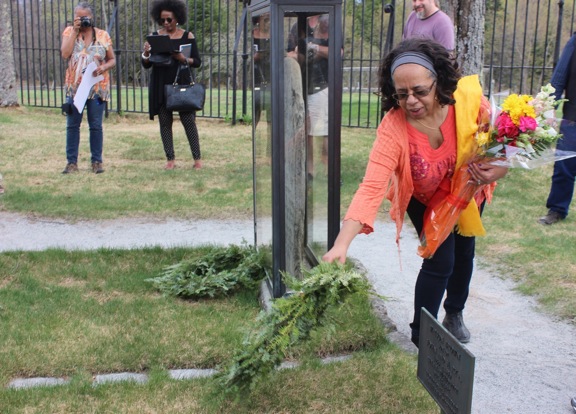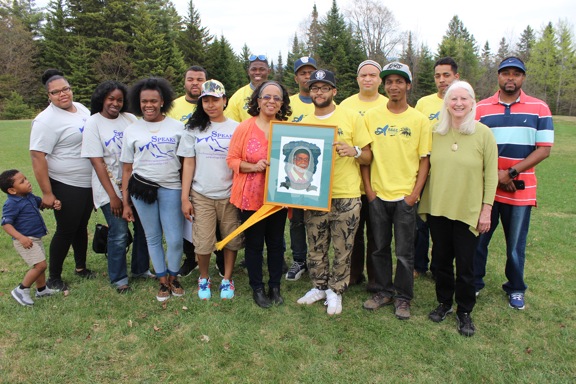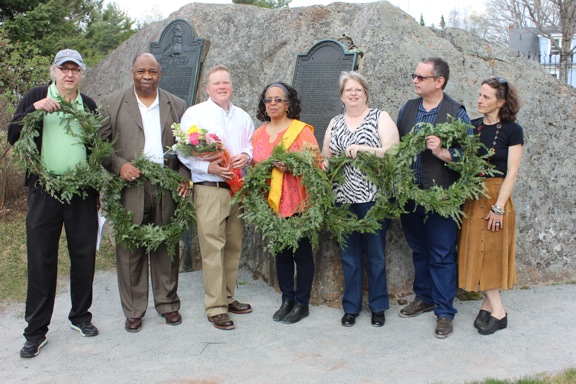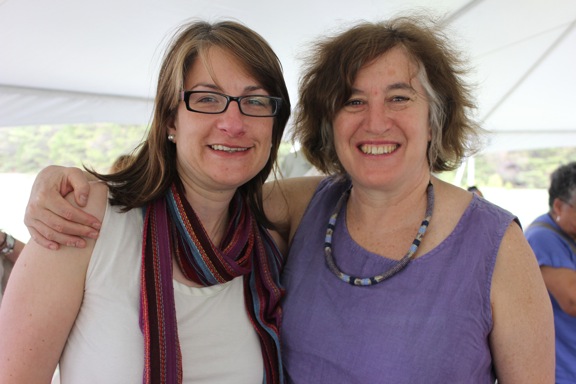ON THE SCENE: Following one’s passion

Cherrie Burgess lays a wreath at the John Brown farm gravesite. (Photo — Naj Wikoff)
Two people who lived and died nearly 150 years apart were honored Saturday, May 9 at the John Brown Farm State Historic Site: abolitionist John Brown and the environmental social activist Brother Yusuf Abdul Wasi Burgess.
They both changed people’s lives. They both had a passion and followed it. They both believed the time for action is now, not on some future date.
Brown and Burgess both faced hardship, overcame difficult obstacles and were ready for action at a moment’s notice. For Burgess, that meant having two kayaks seemingly permanently attached to the top of his car no matter where he went, as he never knew when an inviting pond, river or lake might be passed by. For Brown, that meant being ready at any time to initiate action that could lead to the end of slavery.
Burgess was an inner-city kid from the tough neighborhoods of Brooklyn. His introduction to nature was seeing bees, butterflies and beetles in Prospect Park and wondering what they were about. His introduction to the Adirondacks was not as a visitor on vacation but as a prisoner in a state Department of Corrections bus heading north to do time. At Camp Gabriels, the former minimum-security facility, he reconnected with nature through their recreation program then led by outdoor guide Joe Hackett. Burgess found being on a pond in a canoe a place of release, an experience he decided to share with other inner-city kids, and did so after prison with a vengeance.
Saturday’s event was organized by Martha Swan, of John Brown Lives! After opening remarks by Swan and Alane Ball Chinian, regional director of the state Office of Parks, Recreation & Historic Preservation, the ceremony was led by civil rights activist Dr. James Carter, who participated in the “Bloody Sunday” march in Selma, Alabama, where state troopers attacked and viciously beat protestors attempting to cross the Edmund Pettis Bridge on March 7, 1965, resulting in more than 50 people hospitalized.

Cherrie Burgess and Ann Harrison pose with teens mentored by Brother Yusuf Burgess and involved in environmental studies/activities. (Photo — Naj Wikoff)
“After being here for a few minutes, and looking at each one of you, I wonder, and I am sure John Brown felt the same way, who could hate anybody who looks so beautiful,” said Dr. James Carter. “That’s simply how I look at human beings. They are beautiful, and for people to hate each other I’ve never been able to understand that. I don’t look like you, I don’t think like you, I don’t dress like you, but we are all human beings, and I think we should all look at each other as being beautiful.
“Captain John Brown was a man ahead of his time. Without his heroism, there would not be a precedence for you and I to talk about. One hundred and fifty years ago, he gave the ultimate sacrifice, his life. When I think about Brown, I also think about Dr. Martin Luther King who 50 years ago also gave the ultimate sacrifice, his life, for human rights in this country. John Brown decided in 1858 that there is no time like the present time to do what was right. He did not want to wait any longer for things to stay the same.”
Carter then went on to describe many of the injustices here in our country that need to be righted, now, and not at some distant time in the future giving such examples as there being more young black men incarcerated in our prisons than are enrolled in our nation’s universities. He called on us too to take action, to not put off what needs to be addressed or hope some other person or persons will address the problems before us.
Brown biographer and historian Louis DeCarlo, who has written more books on Brown than any other and has two more in the pipeline that will be published this summer, followed Carter.
“Certainly John Brown, as the single-minded man on the right side of history, who has been dismissed time and time again, keeps coming back. Why?” he said. “Because you can’t bury the truth, because his life was not a life of reinvention, because if you study his life you see that he is really the same man throughout. He did not believe slavery would be uprooted simply by moral suasion. John Brown saw that every road to ending slavery was blocked by power. He felt it had become something that had to be resisted.

John Brown Day speakers pose with wreaths. (Photo — Naj Wikoff)
“The government was on the side of the slaveholder. There was no hope for peaceful emancipation. There was only one man in 1849 who took action, and that was John Brown. He is significant to us because he really represents the ideas and principles that we say we believe in, but often times we as a nation to this day continue to have a double standard and a mythology about what our country is. John Brown does not allow that mythology to exist. He demands that we revisit the history of our country and tell the truth.”
Brother Yusuf attacked that power through education and through connecting young people to nature. As an example, in her moving eulogy to Brother Yusuf, Dr. Hadley Kruzek-Aaron, the SUNY Potsdam professor leading the archeological dig at the Epps farm, spoke of his efforts to educate black students about nature that included bus trips from the Boy and Girls Club and the Albany Green Tech Charter School. She noted that at one time the bus stopped at a Stewart’s somewhere in the middle of the Adirondacks, and another customer walked up and said to Yusuf, “This must be a basketball team,” to which he immediately responded, “No, these are students from a history class taking a field trip to learn more about their history.”
Ann Harrison of the state Department of Environmental Conversation spoke of the many young inner-city students that Brother Yusef and his wife Sherry brought up to attend week-long environmental camps run by the DEC. Recent college graduate Adam Stewart, who had been mentored by Brother Yusuf, spoke eloquently about the attention he gave to each of his many charges, an effort now being carried forward by his wife, sons and others who came under his watchful eye.
“It was very humbling being here today, very informative, and it certainly reinforced my spirit to continue the work he started over 150 years ago,” said Carter. “What we are trying to do now is the legacy he left for us.”
“John Brown saw, I think, a bigger picture and that is world peace is very much related this kind of issue, abolition,” said Dr. Carl George. “You have to recognize that we still have significant enslavement, and that includes the poverty within urban peoples who have no access to places like us.”

SUNY Potsdam professor Hadley Kruzek-Aaron and author Amy Godine (Photo — Naj Wikoff)
“Today was pure love, pure heat and soul,” said Martha Swan.
- Cherrie Burgess and Ann Harrison pose with teens mentored by Brother Yusuf Burgess and involved in environmental studies/activities. (Photo — Naj Wikoff)
- John Brown Day speakers pose with wreaths. (Photo — Naj Wikoff)
- SUNY Potsdam professor Hadley Kruzek-Aaron and author Amy Godine (Photo — Naj Wikoff)





